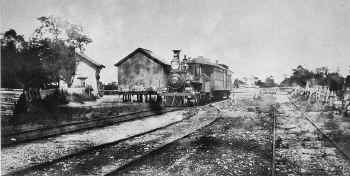|
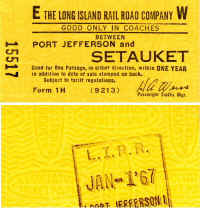
Port Jefferson - Setauket
01/01/67
Archive: Brad Phillips
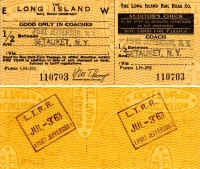
Port
Jefferson - Setauket
07/03/63
Archive: Brad Phillips
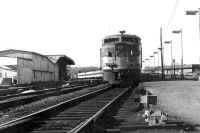
Loper
Bros Lumber - FA2 #602 C420 #202 view W 12/1971 Archive: Dave Keller
|
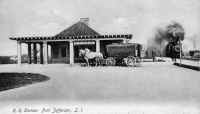
Port
Jefferson view E c.1903
Note: Hopper on team track for Loper Bros Coal. south of main on team
track. Eastbound semaphore behind train.
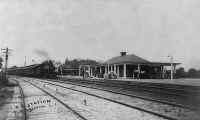
Port
Jefferson view W c.1903
Note: Semaphore wires and rollers in foreground. Info: Dave Keller
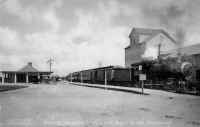
Port
Jefferson LIRR #213 4-4-0
Class D16b view E c.1907
E. H. Rogers Feed & Grain south of main on team track. Note sign: "BICYCLE
RIDING on this platform is PROHIBITED" and semaphore signals
now moved to front of station.
|
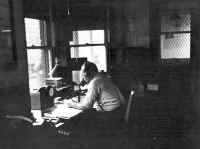
An interior view of the Port Jefferson ticket office and "JF"
block station with the block operator talking with the dispatcher on
the flexi-phone at the operator's desk which was built into the ticket
office bay window to allow visibility in each direction down the
track. Note the table machine to operate the block signal and
also note that this machine was originally manufactured to control two
block signals, eastbound and westbound, but the eastbound one,
including large round indicator dial, was removed in 1938 with the end
of service east of this station to Wading River. This view is c.
1945. (George Christopher photo, Dave Keller archive)
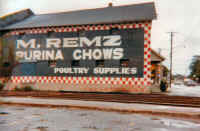
M. Remz Bros. Feed (after 1931, as per
Emery map). View S 1978
Photo: Steve Lynch
|

Robert
M. Emery map of Port Jefferson pre-1920 MP57-58
(Dave Keller archive)
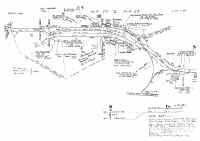
Robert
M. Emery map of Port Jefferson MP57-58 effective 9/1957 showing the
west yard, station facilities, east yard, wye and wye access tracks.
(Dave Keller archive)
|
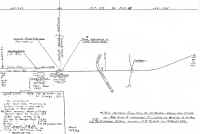
Robert M. Emery map of
Port Jefferson MP58-59 effective 9/1957 showing the tracks and end of
track east of the station as indicated in the general order noted in the
end-of-track image further down on this page. The right portion of this
map also shows the beginning of the Wading River extension as it looked
in 1925. (Dave Keller archive)
|

LIRR 1950 Port Jefferson
P-54
Track Capacity Map
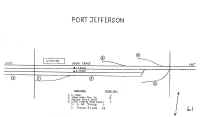
LIRR 1966 Port Jefferson
track map - page 61
|
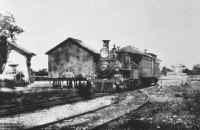
One of the earliest if not THE earliest of LIRR railfan
photographers was George Brainerd who worked for the Brooklyn Union
Gas Co. Back in the late 1870s, he lugged his large glass plate
negative camera and tripod out east from his residence in Brooklyn and
photographed many of the original station buildings along the South
Shore, Main Line, Locust Valley (rails had not yet reached Oyster Bay)
and Port Jefferson branches. This terrific image shot by
Brainerd in 1878 shows an old 4-4-0 American-type locomotive laying up
with a two-car train westbound at the original Port Jefferson station
and freight house west of Coram Rd. (Main St.
- current SR #112). The view is looking east and the depot
building, which resembled the structure at St. James, and which
survived from 1903 until the mid-1960s as the freight/express house,
is at the far left. The tracks would not yet extend to Wading
River for another 20 years. (George Brainerd photo, Dave Keller
archive)
|
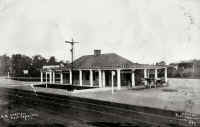
A local professional photographer whose studio was in Port
Jefferson for many years was Arthur S. Greene. In 1905 he
photographed the 2-year-old station building at Port Jefferson.
This depot was built by the developers of nearby Belle Terre, and
resembled the architecture of the two pergolas they erected
overlooking the Long Island Sound. Built on the northeast
quadrant of the crossing of Patchogue-Port Jefferson Road (later route
112) this new brick structure replaced the original wooden one shown
previously which was located on the northwest quadrant of that
crossing. This view is looking northwest and shows Greene's
signature pinto pony and wagon . . . usually found in many of his
photographs. Also visible is the block signal out front of the
depot building, with two semaphore blades, one eastbound and one
westbound as the branch now extended further east to Wading River.
(Thomas R. Bayles collection, Dave Keller archive)
|
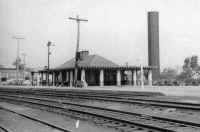
Looking northwest, we see the Port Jefferson depot as it looked in
1938 after service to Wading River was curtailed. The semaphore
blade for the eastbound block signal has been removed from the mast as
there was no longer any through service past this station stop.
(George Christopher photo, Dave Keller archive)
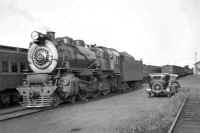
G5s #22 West Yard Port Jefferson
View E c.1935 Port Jefferson had two yards. One east of the
station and one west. The yard west of the station and west of
Route 112 was known, for some unusual reason as the West Yard.
This c. 1935 view looking east towards Route 112 and the station area,
shows G5s class (4-6-0) locomotive #22 laying up westbound in the West
Yard. (Dave Keller archive)
|
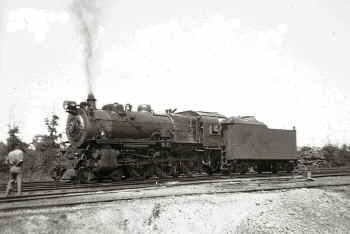
Also laying up in the West Yard, at the west end near the ashpit tracks is G5s #32. This c. 1935 view, looking northeast, was photographed just a short distance east of where the yard branched off the main, and was, for a number of years, adjacent to a turntable, which was later replaced bye a wye track located east of the station and south of the yard. (Dave Keller archive)
|
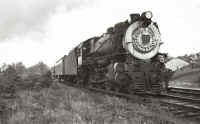
Commemorating the last day
of steam on Long Island, a railfan extra (fan trip) was held on
October 16, 1955, pulled by G5s #35. In this view we see
the locomotive, tender and lead car just having been cut from the
train preparing to back onto the wye track east of the Port Jefferson
station. After being turned on the wye, it will head up the
west leg of the wye track, connect to the front of the train it
just pulled eastward, and head back west with its complement of
railfans of the day. (Dave Keller archive)
|
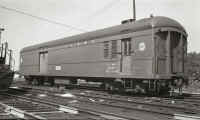
Laid up in the Port Jefferson yard in September, 1963 is
combination RPO (Railway Post Office) and baggage car #7737. The
car still sports modernization number 487 which it's worn since it was
renovated in the LIRR's modernization program of cars which
began in December of 1954 and lasted several years. Visible
across the small door accessing the postal facility is the swing bar
that would be rotated perpendicular to the car and catch, while
traveling non-stop, leather mailbags hung from a trackside mail crane
to be sorted and cancelled en-route. Also note the bars across
the windows protecting the mail compartment from burglary. U. S.
Railway Mail Service employees carried side arms in the completion of
their duties. (Wm. Lichtenstern photo, Dave Keller archive)
|
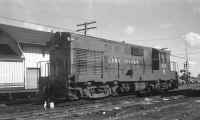
Fairbanks-Morse model H16-44 #1507 is seen here laying up in front
of the former and original wooden depot building at Port Jefferson on
October 24, 1962. Once the new brick depot was constructed in
1903, this old depot was relegated to freight and express use and
lasted until the mid-1960s. This view is looking northeast.
The station is at the far right, on the other side of the crossing of
Route 112. The cars visible are in the station parking lot.
(George E. Votava photo, Dave Keller archive)
|
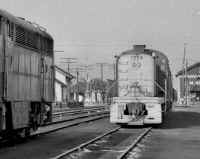
Looking due east in the West
Yard in 1957, we see ALCO RS3 #1554 laying up alongside a
Fairbanks-Morse C-liner. In the distance at the right is M.
Remz's Feed store, many years a landmark, with its notable
"Checkerboard Square" pattern, which was Purina Chow's logo.
In the left background is visible the original depot in use as a
freight / express house and the 1903 depot beyond. For fun,
compare this image side-by-side with Brainerd's 1878 image!
(Jules P. Krzenski photo, Dave Keller archive)
|
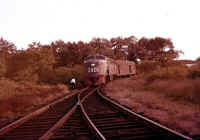
Fairbanks-Morse C-liner (model CPA24-5) #2401 is backing an RPO-Baggage
car onto the wye east of the Port Jefferson station in 1955 so its
train can head back west again. View is looking southwest. This
area today is all built-up commercially. (W. H. Higginbotham
photo, Dave Keller archive)
|
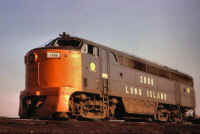
Fairbanks-Morse C-liner (model CPA20-5) #2002 is laying up in
the late afternoon sun in the yard at Port Jefferson c. 1963 (Dave
Keller archive)
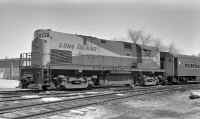
ALCO C420 #201 and train is laying up westbound in the yard east
of the station on April 5, 1964 (George E. Votava photo, Dave Keller
archive)
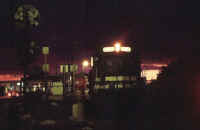
September 20, 1999 LIRR GP38-2 #272 is at the platform taking in
passengers as the sun is rising on Port Jefferson Station view E
Photo: William J. Skeats.
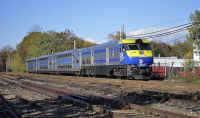
LIRR #400 DE30AC passing the West Yard on 10/03/2010 as the leaves
are changing Photo: William J. Skeats
|
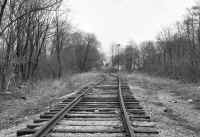
After non-productive revenue
service to Wading River during the many years of the Great Depression,
when steam trains were replaced by self-propelled gas cars
("doodlebugs") to cut down on operating expenses, it was
finally decided to cut the 1898 branch extension back to Port
Jefferson. The last revenue train ran on October 9, 1938 and a
little over 5 months later the following general order was issued:
GENERAL
ORDER #1006C, EFFECTIVE 3/29/39:
SINGLE
TRACK FROM A POINT 1,550’ EAST OF EAST LEG OF WYE, PORT JEFFERSON
STATION TO WADING RIVER
STATION OUT OF SERVICE.
WESTWARD
LOWER QUADRANT SEMAPHORE DISTANT SIGNAL LOCATED
EAST OF PORT JEFFERSON STATION OUT OF SERVICE
This
view, looking due east, shows that point of single track "1,550'
east of east leg of wye" as it looked in 1968, disappearing into
nothing . . . . not even a bumper block or crossed railroad
ties. With the rebuilding of the yard and installation of modern
facilities east of the station, this last vestige of rails to Wading
River was torn out. (Dave Keller photo and archive) |
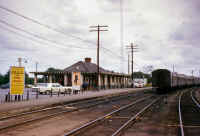
The Port Jefferson depot midday view NE in the Spring/Summer of
1963. A playbill for "Enter Laughing" starring Alan Arkin, Vivian Blaine, Sylvia Sidney, Michael J. Pollard, and Alan Mowbray is attached to the platform light pole at the left.
Archive: Brad Phillips
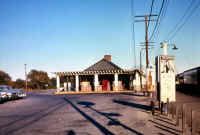
The Port Jefferson depot is
caught in the late afternoon sun in October, 1964. Long shadows
of the position-light block signal and telephone poles are cast in the
station parking lot in this view looking due east. A playbill
for "What Makes Sammy Run" starring Steve Lawrence, Robert
Alda (Alan's dad) and Sally Ann Howes is attached to the platform
light pole at the right. (Dave Keller archive)
|
|
|
